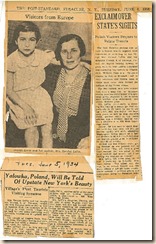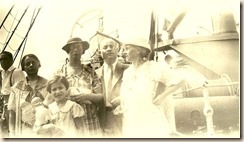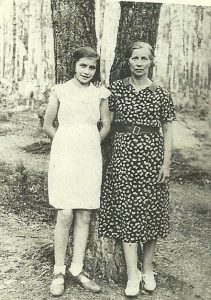Friedel Jelin Lewin (c 1894-1942) and Daughter Dvorah (1924-1942) Visit Syracuse
Thanks to some feedback and suggestions from cousin Ron and cousin Nancy, I have updated this post a little as of 3 May 2020. I see that the story of Jeanette Jelin needs to be filled in, and that I need to address the issues of family names that changed in spelling from the old country to the new. Posts for the future.
Beginning in late 1899 the children of Abraham David Jelin began emigrating to the U.S. from Jalowka, Poland. The three older sisters who would migrate were here by 1912 (see my post about them), and the two youngest siblings came in 1921 (Samuel Jelin arriving in Boston 12 April 1921) and after 1926 (Jeanette). One other sibling, Merke, had married in Jalowka and migrated with her husband Joseph Braude to Buenos Aires in 1925. In addition, the family’s widowed mother Chaja Feiga Jelin emigrated in 1926. In 1926 when Chaja and her youngest daughter, Shayne or Jeanette, had planned to travel together to Syracuse to join the others, it turned out that there were restrictions in place (Immigration Act of 1924). Chaja and Shayne did not know when they started their journey that the new restrictions were in place, only discovering it when they arrived in England for the trip to the U.S. The mother, Chaja, was allowed to travel directly to her daughter in New York, but Jeanette could not come into the country on the strength of her sibling relationship. Complications ensued, but she was eventually able to enter the country in May 1929 and finally join the rest of the family here.
I have written in the past about this family and their emigrations from Poland, including that Friedel was the only one of the siblings not to emigrate. Friedel had married Hersh Lewin in Jalowka, Poland, the small village where the Jelin family had lived, and she and her family did not emigrate. I don’t know of any family story about why they too did not leave Poland after the first World War. At any rate, in the Spring and early summer of 1934, Friedel Lewin was able to visit her sisters and brother and mother after many  years of separation.
years of separation.
Friedel and her daughter Dvorah Lewin sailed from Gdynia Poland on March 1, 1934 on the S.S. Pulaski and arrived in New York City on March 14, 1934. They were reported on the passenger list to be going first to Friedel’s brother-in-law, Meyer Lewin, in the Bronx for a few days. Their ultimate goal was Syracuse where Friedel’s mother (and sisters and brother) lived.
 There aren’t many family stories about their stay in the U.S. that have been passed on to me, but there is a newspaper article at the time that gives a good description of their experiences. The paper reported that they had been to Niagara Falls, Watkins Glen, Thousand Islands, as well as Syracuse, and that they planned to go to Chicago to see the World’s Fair before returning home to Poland. Dvorah, who was a school girl at the time, had attended some classes while in Syracuse and learned some English as well as other academic subjects.
There aren’t many family stories about their stay in the U.S. that have been passed on to me, but there is a newspaper article at the time that gives a good description of their experiences. The paper reported that they had been to Niagara Falls, Watkins Glen, Thousand Islands, as well as Syracuse, and that they planned to go to Chicago to see the World’s Fair before returning home to Poland. Dvorah, who was a school girl at the time, had attended some classes while in Syracuse and learned some English as well as other academic subjects.
The family tried to persuade Friedel to stay in the U.S., or else to try to go to Argentina where their sister Merke had settled. However, she had a husband and three sons in Poland and had to return to them. There is the feeling that her husband put pressure on her to return by telling her, untruthfully, that one of their sons was very ill. Regardless, she and Dvorah did return to Poland. This picture shows them onboard the ship, Dvorah with a doll she had been given.
else to try to go to Argentina where their sister Merke had settled. However, she had a husband and three sons in Poland and had to return to them. There is the feeling that her husband put pressure on her to return by telling her, untruthfully, that one of their sons was very ill. Regardless, she and Dvorah did return to Poland. This picture shows them onboard the ship, Dvorah with a doll she had been given.
 Friedel did correspond occasionally with the family for the next year or so at least. There are two letters, from 23 Dec 1935 and 22 Dec 1936, that report a little about how the family in Poland is doing and show that Friedel missed her sisters and family and wanted to stay connected (thanks to cousin Ron for making sure these got translated). One of the letters noted that it was Dvorah’s 11th birthday and the 4th Hannukah candle, so this helps set her birthdate. There is also a picture of the two of them from 1939 that shows Dvorah had grown a lot. Based on information about her birthdate, and the fact that the picture was not taken in the winter, Dvorah would have been 14.
Friedel did correspond occasionally with the family for the next year or so at least. There are two letters, from 23 Dec 1935 and 22 Dec 1936, that report a little about how the family in Poland is doing and show that Friedel missed her sisters and family and wanted to stay connected (thanks to cousin Ron for making sure these got translated). One of the letters noted that it was Dvorah’s 11th birthday and the 4th Hannukah candle, so this helps set her birthdate. There is also a picture of the two of them from 1939 that shows Dvorah had grown a lot. Based on information about her birthdate, and the fact that the picture was not taken in the winter, Dvorah would have been 14.
Cousin Nancy provided some historical information1 about Jalowka and what happened there in the 2nd World War. “A Yiddish school was opened in Jalowka between the world wars, and a Zionist youth movement was active. The Germans captured Jalowka in June 1941 and instituted a regime of forced labor and extortion. On 2 November 1942, all 600 of the town’s Jews and some refugees were taken to the Wolkowysk transit camp. After a month, they were sent directly to the gas chamber of Treblinka death camp.”
At the end of the War, although the family, Friedel’s brother Samuel Yellin specifically, tried to find out about what happened to her and her family, there was no information to be found. I don’t know if anyone has tried in the last few years. Based on the history, sometime between June 1941 and the end of December 1942, the family members were presumably killed. Dvorah would have been just 18 if she lived to her birthday in 1942.
- Spector, Shmuel and Geoffrey Wigoder. The Encyclopedia of Jewish Life Before & During the Holocaust. New York: New York University Press, 2001 ↩


Leave a Reply